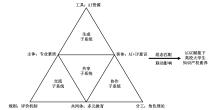
• •
AIGC赋能高校大学生知识产权素养培育路径优化研究
- 1. 河海大学 图书馆,南京 210098
2. 南京奥凯知识产权服务有限公司,南京 210000
-
收稿日期:2025-08-23出版日期:2025-10-29 -
通讯作者:高冕 -
作者简介:封丽(1982- ),女,硕士,中级,研究方向为知识产权素养教育
郭泊池(1988- ),男,本科,研究方向为知识产权信息分析
-
基金资助:2025年江苏省图书馆学会课题“生成式人工智能视域下大学生知识产权素养提升路径研究”(25YB093); 2025年河海大学图书馆馆内项目“高校知识产权素养教育影响因素及成效提升策略研究”(TSG2025B03)
Optimizing the Path of Cultivating Intellectual Property Literacy among College Students through AIGC Empowerment
FENG Li1, GUO Bochi2, GAO Mian1( )
)
- 1. Library of Hohai University, Nanjing 210098
2. Nanjing Aokai Intellectual Property Services Co. , Ltd. , Nanjing 210000
-
Received:2025-08-23Online:2025-10-29 -
Contact:GAO Mian
摘要:
【目的/意义】 探索AIGC赋能下知识产权素养教育的影响因素及实施路径,对于突破传统教育模式中专业壁垒高、师资力量不足以及时空制约等困境,具有重要现实意义。 【方法/过程】 基于高校大学生知识产权素养教育现状,运用文献调研与模糊集定性比较分析(fsQCA)方法,构建AIGC赋能的影响因素模型及高校大学生知识产权素养教育影响因素调查量表,识别多要素协同作用下的组态路径,系统解析人工智能融入知识产权素养教育的作用机制。 【结果/结论】 研究发现,AIGC驱动下大学生高知识产权素养培育存在3条组态路径,不同条件要素通过多样化组合形成协同效应。其中,教师专业素质、AI+IP意识与多元教育支持在关键路径中具有主导作用,评价机制与AI资源在不同情境下发挥补充或增强功能。研究印证了影响因素模型的逻辑结构,揭示了AIGC赋能素养教育的多元机制,并依据活动理论提出了数智时代背景下提升大学生知识产权素养的可行性建议,为优化AI时代高校大学生知识产权素养教育提供理论支持与实践指导。
中图分类号: G258.6
引用本文
封丽, 郭泊池, 高冕. AIGC赋能高校大学生知识产权素养培育路径优化研究[J/OL]. 农业图书情报学报. https://doi.org/10.13998/j.cnki.issn1002-1248.25-0444.
FENG Li, GUO Bochi, GAO Mian. Optimizing the Path of Cultivating Intellectual Property Literacy among College Students through AIGC Empowerment[J/OL]. Journal of library and information science in agriculture. https://doi.org/10.13998/j.cnki.issn1002-1248.25-0444.
表1
变量测量题项及测量内容"
| 变量 | 测量题项及内容 | 来源 |
|---|---|---|
| 专业素质 | ①教师熟悉掌握AI工具,并持续关注自身能力的提升,不断更新知识储备 ②教师拥有扎实的知识产权专业知识和教学技能,能将AIGC融入教学过程 ③教师能够利用AIGC设计个性化的知识产权教学方案,满足不同学生学习需求 ④教师利用AIGC提供场景模拟,将知识产权知识和技能运用到创新创业指导 | [ |
| AI+IP意识 | ①使用AIGC辅助知产学习时,我会主动检查其数据来源的合法性与内容的合规性 ②使用AIGC辅助知产学习时,我会严格遵守生成内容的权利归属规则,并尊重原创者与权利人的合法权益 ③使用AIGC辅助知产学习时,我认为有责任确保整个过程符合道德规范与法律法规 ④我认为AIGC对于知识产权课程的学习具有重要的应用价值 | [ |
| 多元教育 | ①学校设置人工智能基础课与融合课模块,积极打造“人工智能+”知识产权课程体系 ②知识产权课程由图书馆、创业创业指中心、人工智能等学院协同开展 ③学校紧抓AIGC发展机遇,开展多元化的AI+知识产权科普活动 ④学校会依托联合导师、项目合作、实训实习等方式,开展人才校企联合培养 | [ |
| 角色分工 | ①在AIGC协作教学中,各参与主体角色分工明确,协作高效顺畅 ②教师与AIGC通过协同教学设计与质量评估达成行动共识、角色共识 ③学习者利用AIGC根据自身需求定制与获取学习资源,拥有充分的交互自主权 ④活动相关主体在价值理念上达成利益一致、目标同向,在实践中实现行动协同 | [ |
| 评价机制 | ①AIGC反馈的过程数据,有助于教师及时调整知识产权教学策略 ②AIGC反馈的学情数据,能准确反映我的学习进展,有助于调整个人学习策略 ③AIGC可根据定制化的需求进行拓展,提供个性化的指导建议 ④我觉得引入AIGC的过程评价机制,可显著提升知识产权素养培育效果 | [ |
| AI资源 | ①学校在知识产权通识课程教学中嵌入AIGC辅助教学功能 ②学校拥有AI+知识产权数字资源库和分析工具,帮助学生快速查找和分析相关资料 ③学校建设AI+智能教学系统,集成智能助教、智能学伴、知识图谱等,为学生提供个性化知识产权学习服务 ④学校建有AI+虚拟仿真实验平台,为学生提供模拟的知识产权实践场景 | [ |
| 知识产权素养 | ①我不仅熟悉知识产权的基础理论与法规,更能主动运用AIGC,将理论知识转化为实际应用能力 ②我具备识别和评估日常知识产权风险的能力,善于利用AIGC分析潜在问题,并制定避免侵权的策略 ③我在学习和生活中坚持尊重并合法使用他人知识产权,运用AIGC进行合规性验证,确保行为正当 ④我能有效运用知识产权知识来保护个人创新,并积极借助AIGC,主动维护自身的知识产权权益 | [ |
表3
信度和效度检验结果"
| 变量 | 测度项 | 因子荷载 | Cronbach's α | AVE | CR |
|---|---|---|---|---|---|
| 专业素质 (A) | A1 | 0.782 | 0.853 | 0.593 | 0.853 |
| A2 | 0.767 | ||||
| A3 | 0.749 | ||||
| A4 | 0.782 | ||||
| AI+IP意识(B) | B1 | 0.792 | 0.858 | 0.601 | 0.858 |
| B2 | 0.765 | ||||
| B3 | 0.767 | ||||
| B4 | 0.777 | ||||
| 多元教育(C) | C1 | 0.731 | 0.860 | 0.606 | 0.861 |
| C2 | 0.787 | ||||
| C3 | 0.788 | ||||
| C4 | 0.806 | ||||
| 角色分工(D) | D1 | 0.804 | 0.862 | 0.610 | 0.862 |
| D2 | 0.742 | ||||
| D3 | 0.782 | ||||
| D4 | 0.796 | ||||
| 评价机制(E) | E1 | 0.784 | 0.857 | 0.616 | 0.857 |
| E2 | 0.762 | ||||
| E3 | 0.810 | ||||
| E4 | 0.744 | ||||
| AI资源 (F) | F1 | 0.785 | 0.865 | 0.656 | 0.866 |
| F2 | 0.795 | ||||
| F3 | 0.779 | ||||
| F4 | 0.781 | ||||
| 知识产权素养(X) | X1 | 0.812 | 0.884 | 0.656 | 0.884 |
| X2 | 0.800 | ||||
| X3 | 0.832 | ||||
| X4 | 0.794 | ||||
| KMO=0.929 近似卡方=6 130.030 Sig=0.000 | |||||
表4
单一变量必要性检验结果"
| 变量 | 高知识产权素养 | 非高知识产权素养 | ||
|---|---|---|---|---|
| 一致性 | 覆盖度 | 一致性 | 覆盖度 | |
| 专业素质 | 0.770 775 | 0.672 269 | 0.536 124 | 0.437 082 |
| ~专业素质 | 0.354 598 | 0.449 888 | 0.598 003 | 0.709 175 |
| AI+IP意识 | 0.760 742 | 0.668 090 | 0.544 011 | 0.446 568 |
| ~ AI+IP意识 | 0.369 817 | 0.464 572 | 0.595 664 | 0.699 438 |
| 多元教育 | 0.797 150 | 0.661 301 | 0.566 671 | 0.439 412 |
| ~多元教育 | 0.324 253 | 0.444 612 | 0.563 209 | 0.721 853 |
| 角色分工 | 0.778 498 | 0.669 110 | 0.544 217 | 0.437 214 |
| ~角色分工 | 0.345 208 | 0.447 603 | 0.588 127 | 0.712 796 |
| 评价机制 | 0.786 717 | 0.696 420 | 0.504 822 | 0.417 708 |
| ~评价机制 | 0.342 209 | 0.425 072 | 0.633 106 | 0.735 071 |
| AI资源 | 0.770 722 | 0.667 411 | 0.546 024 | 0.441 966 |
| ~AI资源 | 0.355 585 | 0.455 922 | 0.589 103 | 0.706 024 |
| [1] |
苏联工智能生成内容(AIGC)白皮书[R]. 北京: 中国信息通信研究院, 京东探索研究院, 2022: 4.
|
| [2] |
吴丹, 白芳睿. 数智赋能信息资源管理学科“双核四驱”教学模式优化研究: 以信息描述课程为例[J]. 图书馆学研究, 2025(2): 35-43.
|
|
|
|
| [3] |
李浩君, 黄沁儒, 陈伟, 等. 人智协同迭代共生教学模式研究: AIGC的融入与实践效果分析[J]. 现代教育技术, 2025, 35(1): 81-88.
|
|
|
|
| [4] |
|
| [5] |
詹希旎, 李白杨, 孙建军. 数智融合环境下AIGC的场景化应用与发展机遇[J]. 图书情报知识, 2023, 40(1): 75-85, 55.
|
|
|
|
| [6] |
汪聪, 张春红, 高楠, 等. 面向人工智能生成内容时代的图书馆服务适应与创新[J]. 情报理论与实践, 2024, 47(7): 17-24.
|
|
|
|
| [7] |
刘彩娥, 韩丽风. AIGC背景下高校信息素养教育的发展[J]. 大学图书馆学报, 2024, 42(2): 46-51.
|
|
|
|
| [8] |
华子荀, 王炜, 吴开华, 等. 如何发挥AIGC的教育效能 : 基于响应面分析的数字素养高意识能力培养[J]. 现代教育技术, 2024, 34(9): 14-25.
|
|
|
|
| [9] |
董焕晴, 曹高辉, 庹沛. 生成式AI工具用户信息搜寻行为形成路径——以数字素养与人工智能素养为视角[J]. 图书馆论坛, 2025, 45(10): 152-160.
|
|
|
|
| [10] |
罗青兰, 苏春辉, 秦彩萍, 等. 高校知识产权教育的现状与对策研究[J]. 情报科学, 2007, 25(8): 1167-1170, 1175.
|
|
|
|
| [11] |
中国政府网. 国务院办公厅关于转发知识产权局等单位深入实施国家知识产权战略行动计划(2014-2020年)的通知[EB/OL]. [2024-12-01].
|
| [12] |
中国政府网. 国务院关于印发“十四五”国家知识产权保护和运用规划的通知[EB/OL]. [2024-12-07].
|
| [13] |
黄凯健, 肖可以, 李成林, 等. 中外高校图书馆知识产权素养教育调查与分析[J]. 高校图书馆工作, 2021, 41(6): 66-72.
|
|
|
|
| [14] |
徐春, 张静, 孟勇, 等. 高校图书馆知识产权信息素养教育现状及发展对策研究[J]. 图书馆学研究, 2021(24): 22-30.
|
|
|
|
| [15] |
唱婷婷, 杨新涯, 沈敏, 等. 高校图书馆多层级知识产权素养教育模式研究: 以重庆大学图书馆为例[J]. 大学图书馆学报, 2021, 39(4): 73-80.
|
|
|
|
| [16] |
张建媛, 暴瑛. 基于ACRL高等教育信息素养框架的知识产权素养教育思考[J]. 图书馆界, 2022(5): 61-67.
|
|
|
|
| [17] |
刘彩霞. 高校图书馆工科大学生知识产权素养提升策略研究: 以天津科技大学为例[J]. 图书馆工作与研究, 2022(5): 66-75.
|
|
|
|
| [18] |
刘敏. “双一流”高校图书馆知识产权素养教育现状及优化策略[J]. 图书馆, 2022(2): 51-59.
|
|
|
|
| [19] |
|
| [20] |
鄂丽君, 马兰. 高校图书馆知识产权素养教育研究[J]. 图书馆工作与研究, 2020(4): 106-111, 128.
|
|
|
|
| [21] |
刘杰, 袁永旭, 吴娟. 新质生产力视角下: 高校图书馆知识产权素养教育提升策略研究[J]. 农业图书情报学报, 2025, 37(3): 32-41.
|
|
|
|
| [22] |
刘俊晓, 李爽. 高校科研人员知识产权素养评价指标体系构建研究[J]. 情报科学, 2025, 43(3): 58-68.
|
|
|
|
| [23] |
雷怡, 邓仪友. 知识产权文化素养水平测度及影响因素分析[J]. 知识产权, 2023, 33(9): 108-126.
|
|
|
|
| [24] |
刘朝, 师洪波, 张靖, 等. 研究生通识教育与复合人才培养协调的实证研究: 基于中科院知识产权教育的调查[J]. 研究生教育研究, 2013(2): 39-44.
|
|
|
|
| [25] |
|
| [26] |
|
| [27] |
李剑, 尤伟光, 林静, 等. 面向区域创新的高校图书馆知识产权信息服务绩效评价研究[J]. 情报科学, 2023, 41(6): 161-169, 191.
|
|
|
|
| [28] |
|
| [29] |
|
| [30] |
|
| [31] |
李春秋, 赵胜男, 张萌, 等. 活动理论视角下高校图书馆AI素养培育策略研究[J]. 图书馆学研究, 2025(4): 103-115.
|
|
|
|
| [32] |
陈颖仪. 活动理论视角下公共图书馆全民数字素养教育提升路径[J]. 图书馆工作与研究, 2024(4): 61-69.
|
|
|
|
| [33] |
易凯谕, 韩锡斌. 从混合教学到人智协同教学: 生成式人工智能技术变革下的教学新形态[J]. 中国远程教育, 2025(4): 85-98.
|
|
|
|
| [34] |
陈士林, 苏益南, 何铭. 高校大学生知识产权意识提升研究[J]. 中国高教研究, 2012(5): 77-81.
|
|
|
|
| [35] |
桂橙林, 赵旭宏, 张鹏程, 等. 数智化背景下员工AI意识对其创新绩效的影响机制[J]. 中国人力资源开发, 2024, 41(8): 6-22.
|
|
|
|
| [36] |
耿荣娜. 信息化时代大学生数字素养教育的关键影响因素研究[J]. 情报科学, 2020, 38(9): 42-48.
|
|
|
|
| [37] |
郭胜男, 吴永和. 社会角色理论视域下的人工智能时代教师: 困厄、归因及澄明[J]. 电化教育研究, 2022, 43(6): 18-24, 60.
|
|
|
|
| [38] |
董娜, 陈寞塬, 黄甫全, 等. AI教师身份何以证成: 来自新兴角色理论的回答[J]. 中国电化教育, 2025(5): 42-52.
|
|
|
|
| [39] |
秦渝超, 刘革平, 许颖. 生成式人工智能如何重塑教学活动: 基于活动理论的模型构建与应用[J]. 中国远程教育, 2023(12): 34-45.
|
|
|
|
| [40] |
缪静敏, 沈苑, 汪琼. 生成式人工智能如何改变教学 : 来自高校教师的实践叙事[J]. 中国远程教育, 2025(5): 75-91.
|
|
|
|
| [41] |
刘璐, 张新峰. 产学研协同的人工智能课程教学改革: 以中国科学院大学“深度学习”课程为例[J]. 高等工程教育研究, 2023(6): 73-77.
|
|
|
|
| [42] |
付羽涵, 万倩. 人工智能时代知识产权人才培养模式的反思与重构[J]. 传播与版权, 2023(14): 96-99.
|
|
|
|
| [43] |
|
| [44] |
|
| [45] |
|
| [1] | 沈洪杰, 沈洪伟, 王均莉. 生成式AI赋能数字图书馆信息素养教育:路径探索、挑战分析与应对策略[J]. 农业图书情报学报, 2025, 37(7): 50-60. |
| [2] | 赵亚静. 用户生成内容(UGC)平台中抑郁倾向用户参与行为的影响因素研究[J]. 农业图书情报学报, 2025, 37(6): 70-86. |
| [3] | 施栩婕, 袁帆, 李佳. 生成式人工智能环境下的搜索即学习:技术路径、行为演化与伦理挑战[J]. 农业图书情报学报, 2025, 37(5): 40-57. |
| [4] | 崔少杰, 刘艳萍. 数字素养对乡村治理效能的影响研究——基于山西省夏县306户农村居民的调研数据[J]. 农业图书情报学报, 2025, 37(4): 39-50. |
| [5] | 刘杰, 袁永旭, 吴娟. 新质生产力视角下:高校图书馆知识产权素养教育提升策略研究[J]. 农业图书情报学报, 2025, 37(3): 32-41. |
| [6] | 李晓, 曲建升. 证据合成众包的用户参与意愿影响因素研究[J]. 农业图书情报学报, 2025, 37(3): 92-105. |
| [7] | 乔晋华, 马雪赟. LLaMA人工智能大模型在高校未来学习中心应用的风险与规制[J]. 农业图书情报学报, 2025, 37(2): 37-48. |
| [8] | 马宁, 张孝义, 刘启轩. 信息素养对农民参与电子商务的影响——感知收益与感知风险的中介作用及政府支持的调节作用[J]. 农业图书情报学报, 2025, 37(2): 88-99. |
| [9] | 张超民, 李景成. 新时代推进农民信息素养教育高质量化的多元主体行为策略研究[J]. 农业图书情报学报, 2025, 37(1): 75-85. |
| [10] | 罗国锋, 易童, 闫舟舟. 面向AIGC应用的高校图书馆批判性信息素养教育研究[J]. 农业图书情报学报, 2025, 37(1): 47-58. |
| [11] | 游鸽, 李洁琳, 张帆顺. 信息生态视角下突发公共事件网络舆情热度生成机理研究[J]. 农业图书情报学报, 2025, 37(1): 86-99. |
| [12] | 何慧敏. 基于MOA模型的公共图书馆信息素养教育读者知识建构研究[J]. 农业图书情报学报, 2024, 36(9): 58-69. |
| [13] | 袁帆, 李佳. 生成式人工智能在图书馆信息素养教育中的机遇、挑战与发展方向——一项范围综述[J]. 农业图书情报学报, 2024, 36(9): 44-57. |
| [14] | 韩龙, 郭晋成, 鲁羿廷, 周群. 基于SEM和fsQCA的虚拟兴趣社区用户信息采纳的影响因素研究[J]. 农业图书情报学报, 2024, 36(8): 82-95. |
| [15] | 马晨, 李瑾, 李泽欣, 范贝贝, 冯献. 数字乡村背景下的农民数字素养水平评价与影响因素研究[J]. 农业图书情报学报, 2024, 36(7): 19-33. |
|
||





